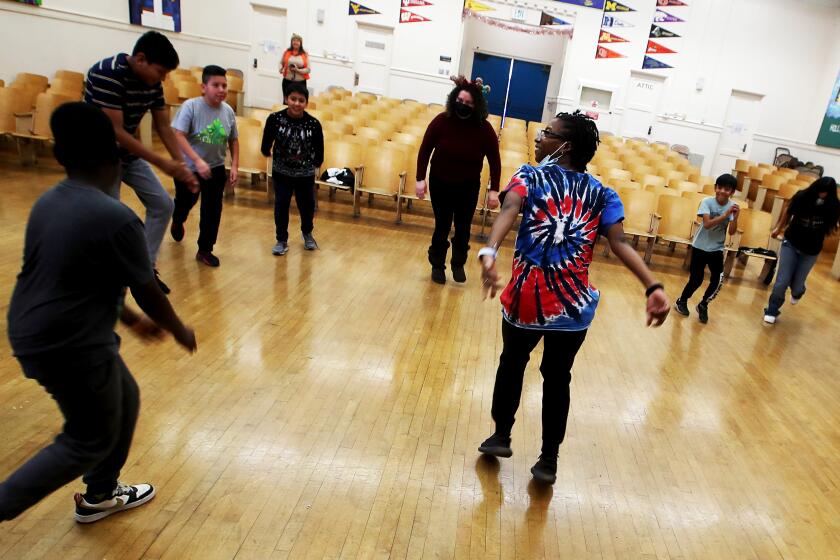Claremont Is Divided Over New Campus
The debate over a proposal to build a new campus for the seventh and newest of the Claremont Colleges is driving a wedge between those who cherish this scholarly city’s academic heritage and those who treasure its open space.
In little more than three years, the proposal has become a pivotal issue in this college hamlet known as “the city of trees and PhDs” about 35 miles east of Los Angeles. It has been the subject of Claremont City Council hearings, rallies, a referendum drive, a lawsuit and vociferous protests.
The Keck Graduate Institute of Applied Life Sciences wants to make its permanent home on a slice of the Robert J. Bernard Biological Field Station, an 87-acre, partially wooded preserve just north of the colleges.
Building that new campus for Keck, a graduate school established in 1997 and devoted to meshing bioscience and management, is proving to be about easy as unraveling the mysteries of DNA.
While Keck’s inaugural class of 28 students is working in a temporary research and development facility southwest of the colleges, other students are using tactics pioneered by environmental groups such as Greenpeace and Earth First! to stop the project.
In the latest scuffle, as many as 100 students converged on the colleges’ main business office at 3 a.m. March 26 and blockaded it for 28 hours. Some of the students then chained themselves to barricades they created using garbage cans, fresh concrete and large pipes.
Protester Lenny Molina called the technique “fighting concrete with concrete.”
“Nothing we genetically engineer [at Keck] can make up for the loss of this natural habitat with its rare coastal sage scrub,” said Molina, a student at Pomona College.
The barricades were designed so that only the students could reach the chains. Eventually, police in riot helmets, aided by a forklift truck, carted off the protesters while they were still tethered to the garbage cans. Nine students were arrested on suspicion of trespassing, and the colleges temporarily suspended all those involved.
But that doesn’t deter Molina and his cohorts. They’ve vowed more disruptions until the colleges promise they will never build on the land. “We’ll tie ourselves to bulldozers if we have to,” said Molina, a thin, wiry junior wearing Trotsky-style glasses.
Even Keck’s inaugural bash last fall had to be relocated from a large tent on its temporary campus south of the colleges to a conference room because of a protest by opponents of construction at the field station.
In this town built by transplanted New England professors and ministers a century ago, where the leafy lanes have names such as Yale and Harvard, the latest turn of events has caught some off guard.
“I was surprised at the intensity of the feelings and the protracted nature of the protest,” Keck Graduate Institute President Henry Riggs said of the latest incident.
However, sooner or later, he said, the college will be built on a portion of the field station. “We’re not backing away from that land. It is being held for future colleges,” Riggs said. “We are going to use the 11.4 acres. The question is timing . . . we’re not in a great rush.”
The field station, at the northeast corner of College Avenue and Foothill Boulevard, was established in 1976. A partially wooded area with coastal sage scrub, sycamores, willows and a small lake, it serves as an outdoor laboratory for college and school botany classes.
The nearby Claremont Colleges were inspired by England’s Oxford University. Keck and each of the prestigious schools that make up the Claremont Colleges--Pomona, Pitzer, Scripps and Harvey Mudd, Claremont McKenna and the Claremont Graduate University--are autonomous and each has its own campus, students, president, faculty and style.
The colleges’ 6,000 students can select classes from any of the other institutions as well as use their libraries and facilities. Though the colleges are independent, they jointly manage much of their business operations through the Claremont University Consortium.
Riggs said the land for the new campus was acquired decades ago and has always been reserved for academic buildings. The consortium set aside the land for Keck in 1997, the same year the college was founded with a $50-million grant from the W.M. Keck Foundation.
KGI, as academics call it, is designed to develop professionals who have both business acumen and graduate-level scientific skills.
Plans call for Keck’s enrollment to grow to about 125 students, with a few PhD candidates sprinkled among those seeking master’s degrees. The consortium hopes to build an 85,000-square-foot complex of offices, classrooms and research facilities.
After two years of contentious hearings and meetings of various city bodies, the City Council last summer approved an environmental impact report and development agreement for the new campus.
Soon afterward, a community group, the Friends of the Bernard Field Station, sued the city and colleges, saying the environmental report for the project was inadequate.
Within a few weeks, another group, the Coalition to Preserve Claremont’s Character, turned up at City Hall with a red wagon filled with the signatures of 3,153 voters--enough to qualify a referendum that would nullify the deal.
The City Council responded by scrapping the development agreement. This eliminated the need for a vote, but one coalition member, Carol Gil, wished the referendum had gone forward. “The residents should have been heard,” she said.
Finally, the colleges and the Friends committee agreed on an out-of-court settlement of the lawsuit in February. “We reached a compromise on the new campus that protects much of the land,” said Brenda Barham Hill, chief executive officer of the consortium.
The Keck campus will be built, she said, but 45 acres of the field station will be set aside for half a century. In addition, she said, the colleges will allow community access to the area and appoint a Native American monitor for the site, once the location of an Indian village.
Nancy Hamlett, a Harvey Mudd biology professor and chairwoman of the Friends group, said the suit at best would have forced the city to do additional work on the environmental report.
“Clearly, the terms of the settlement don’t have everything we’d like,” she said. “But even if we’d won, it’s unlikely we’d prevent this building from being built.”
In this quiet college town of 34,000 known for its tree-lined avenues and cafe lifestyle--where arguments center more on Sartre’s philosophy or relations with China than City Hall--the local issue has created divisions among students, colleagues and friends. One member of the Friends committee who did not agree to the settlement quit the group in disgust.
It’s an agreement that Ruth Cusick, of Students for the Field Station, says she can’t stomach.
“The field station is a fragile ecosystem,” said Cusick, a Scripps College junior who was arrested in the March 26 protest.
Building the Keck college, Cusick said, will trample on an ancient village of the Tongva Indians.
The students said college officials have effectively gagged them by ignoring them. The students advocate alternative sites for the Keck campus at two places rejected by the colleges: a gravel pit in east Claremont and the college-owned golf course.
College officials say the students had a chance to affect the Keck plans at public hearings held by the city. “They feel they haven’t been heard because they haven’t got what they wanted,” Barham Hill said.
Barham Hill said she had no choice but to have the students arrested and removed from blocking the consortium’s office. Otherwise, she added, hundreds of the colleges’ workers would have gone without paychecks because the payroll staff couldn’t get into the building.
“I wouldn’t say no one was hurt,” she said of the arrests. “But a lot of the crying out was phony. It’s something they learn from activist training.”
For some in this highly politicized community, where socialists and a onetime Nazi Party member have run for public office, the field station and Keck are a microcosm of larger debates about land use, corporatism and tampering with nature.
Most of the students in the latest protests will probably be gone by the time the Keck Graduate School is built. The timetable for construction depends largely on how long it takes the school to outgrow its temporary campus, officials said.
Barham Hill said the Claremont University Consortium must negotiate a new development agreement with the city before any construction can begin. That, she said, could take a few years.
More to Read
Start your day right
Sign up for Essential California for news, features and recommendations from the L.A. Times and beyond in your inbox six days a week.
You may occasionally receive promotional content from the Los Angeles Times.







